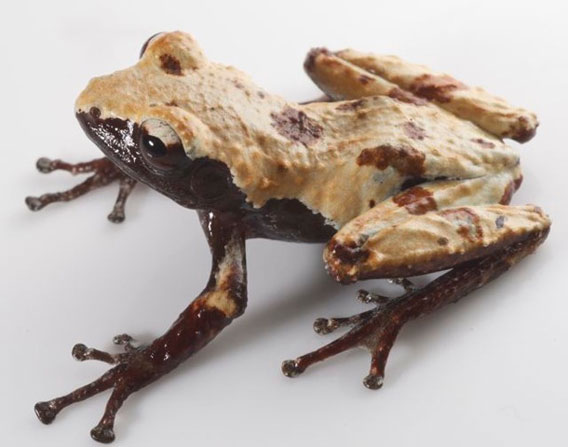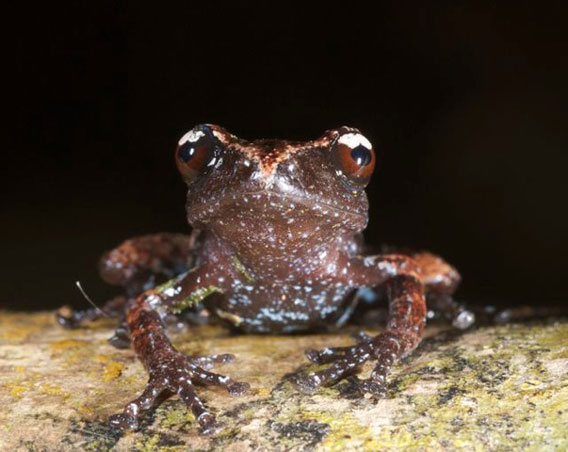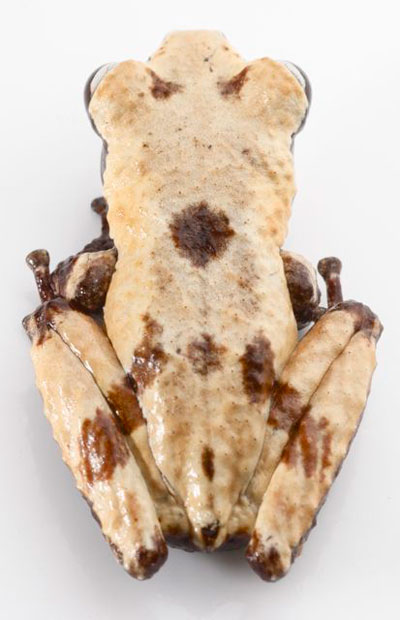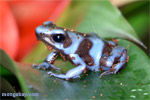
New species of frog: the cloaked moss frog (Theloderma palliatum). Photo by: Jodi J. L. Rowley/Australian Museum.
Researchers have discovered two new frog species living in the montane tropical forests of Vietnam. Known as moss frogs, these small amphibians employ camouflage as one way to keep predators at bay, in some cases resembling the moss that gives them their name.
The new species have been evocatively dubbed the misty moss frog (Theloderma nebulosum) and the cloaked moss frog (Theloderma palliatum). The first was named after its misty habitat on Kon Tum Plateau, while the second was named after its ability to change the colors and patterns along its back. The frogs are less than 3 centimeters (1.18 inches) long, around the size of a small paper clip.
Both frogs were discovered above 1,500 meters (4,900 feet), but the misty moss frog survives at 2,000 meters (6,500 feet) in a climate that hits 5 degrees Celsius (41 degrees Fahrenheit) in cold months.
 Second new species: the misty moss frog (Theloderma nebulosum). Photo by: Jodi J. L. Rowley/Australian Museum. |
The frogs’ discoverers fear the species may already be endangered, although both are found in protected areas: the cloaked moss frog in Bidoup-Nui Ba National Park and the misty moss frog Ngoc Linh Nature Reserve.
“They are likely to be restricted to relatively small patches of high-elevation forest on the Kon Tum and Langbian plateaus, and hence particularly vulnerable to threatening processes such as habitat loss and over-collection. […] Collection for the international pet trade is perhaps more of an immediate threat [than habitat loss], even in protected areas, as members of the genus are popular in captivity,” the authors write in a paper published in Zootaxa.
The cloaked moss frog may be particularly rare. According to the paper, researchers only discovered three frogs of this species in 20 surveys carried out over three years. However they add, “due to the small size and arboreal nature of these frogs, the apparent rarity of the species may be due simply to poor detectability.”
Lead author of the paper describing the species, Jodi Rowley with the Australian Museum in Sydney, recently wrote that “Southeast Asian amphibians are both poorly known and highly threatened. Facing the highest deforestation rate on the planet, and huge over-harvesting pressure, Southeast Asian amphibians are being driven towards an extinction crisis. At present, almost one-fifth of Southeast Asian amphibians are listed as threatened. We still don’t even have a reliable estimate of the true amphibian diversity in Southeast Asia, with the current figures being serious underestimates, and new species being continuously discovered. For example, 31 percent of amphibian species known from Vietnam, Laos and Cambodia in 2005 had been described since 1997.”
The world’s amphibians are in the midst of what may well be a mass extinction. If it weren’t enough to be pummeled by deforestation, wetland loss, pollution, overexploitation, the pet trade, invasive species, and climate change, amphibians are also combating a deadly fungal disease called chytridiomycosis. Currently the IUCN Red List has found that 41 percent of the world’s 7,000 known amphibians are threatened with extinction. It’s believed that at least 120 amphibians have gone extinct in the last 30 years.
CITATION: Rowley, J. J. L., Le T. T., D.Hoang D. H., Dau Q. V., & Cao T. T. (2011). Two new species of Theloderma (Anura: Rhacophoridae) from Vietnam. Zootaxa 3098: 1-20.

Another view of the misty moss frog. Photo by: Jodi J. L. Rowley/Australian Museum.

Another view of the cloaked moss frog. Photo by: Jodi J. L. Rowley/Australian Museum.
Related articles
Effort to save world’s rarest frogs recognized with conservation award

(12/05/2011) An effort to save the world’s most endangered amphibians has won mongabay.com’s 2011 conservation award. Amphibian Ark — a joint effort of the World Association of Zoos and Aquariums, the IUCN/SSC Conservation Breeding Specialist Group, and the IUCN/SSC Amphibian Specialist Group — is working to evaluate the status of threatened amphibians, raise awareness about the global amphibian extinction crisis, and set up captive breeding programs. The initiative is targeting 500 species that will not survive without captive breeding efforts.
Smelly frogs may be key to fighting antibiotic-resistant infections
(12/01/2011) Foul smelling frogs may save lives, according to new research in the Journal of Proteome Research. Examining nine species of Chinese frogs, known as “odorous” frogs for their off-putting smell, researchers have discovered an astounding variety of antimicrobial peptides, or put simply bacteria-killers.
Extinct frog rediscovered in Israel
(11/21/2011) After its marshland was drained, researchers thought the Hula painted frog (Discoglossus nigriventer) had vanished for good. However a patrol at the Ha-Hula lake in Israel recently discovered a single female amphibian that turned out to be the long-lost, and long-sought, Hula painted frog.